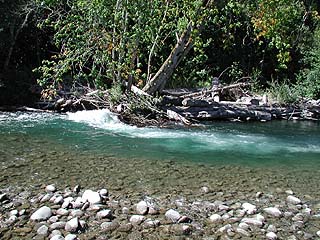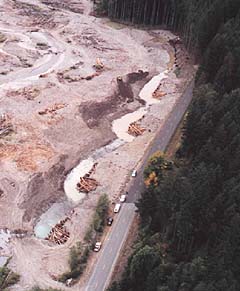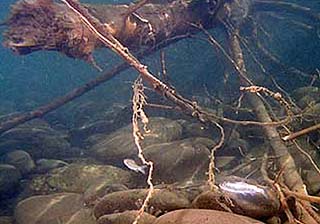
Surveys
DJC.COM
July 17, 2003
Engineered logjams: salvation for salmon
Herrera Environmental

Photos courtesy of Herrera Environmental
An engineered logjam on the Elwha River.
|
Using engineered logjams (ELJs) in place of traditional bank stabilization methods for roadway improvements is a new self-mitigating solution used to restore salmon habitat and prove that sustainable engineering is not only possible, but can at times provide the most practical long-term solution.
Pioneered by Tim Abbe, Herrera’s director of river science and geomorphology, ELJs are designed and constructed as a permanent addition to a channel. ELJs emulate historic conditions and natural processes to rehabilitate aquatic and riparian habitat; provide erosion control, flood diffusion and grade control; and increase sediment retention.
Herrera’s approach focuses on protecting infrastructure while restoring the natural environment. The company’s analysis of a Hoh River reach in Jefferson County is a local example of its use of self-mitigating design and sustainable engineering methods.
The design uses innovative structures to protect Highway 101 infrastructure and enhance aquatic and riparian habitat. The project serves as a model for other locations in the state where infrastructure is in jeopardy and environmental resources cannot be compromised.
Along the Pacific coast, historical information is being used on estuarine marshes to develop roadway improvement techniques that enhance tidal environments. Engineers analyzed the characteristics of historic tide channels in a diked pasture area adjacent to a slough on the Willapa River and recommended infrastructure improvements that would recreate those channels after removal of the dikes.
The big picture
Engineers, scientists and planners are working together to educate clients on the benefits of a “big picture” interdisciplinary approach to projects. Herrera is analyzing channel migration zones in Washington rivers and recommending designs that work with the migrating river channel instead of against it.

A series of logjams were created on the Cispus River to improve salmon habitat.
|
“Over time, river channels change and attempting to constrain the channel is risky,” Abbe said.
Through evaluating an entire reach of a river, more successful bank protection strategies can be provided because the designs are based on a big picture understanding of past problems and their causes throughout the reach.
Interdisciplinary teams work together to achieve a design that avoids potential impacts to a healthy natural environment. When impacts are unavoidable, self-mitigating designs use habitat enhancements while also meeting the engineering project requirements.
“Regulatory agencies in the Pacific Northwest are increasingly seeking infrastructure designs in aquatic environments that accomplish this balance,” said Mark Ewbank, Herrera’s director of surface water engineering. “The challenge is to achieve that balance in a cost-effective way that benefits all involved, including the aquatic species of interest.”
Cutting-edge construction
Innovative designs require innovative construction specifications. Because engineering standards are not available for unconventional structures such as ELJs, the success of their designs depends upon developing a strong protocol to integrate engineering and science.
A strong protocol includes steps to identify the project’s feasibility, characterize and mitigate risk, evaluate system effectiveness and document the design process. One example is using pilings to provide structural integrity and increase the safety of ELJs.
“A piling analysis can be developed specifically for static and dynamic pull-out and thrust — the hydraulic forces in rivers that ELJs must withstand,” said Michael Spillane, Herrera’s director of construction management services. “With our standard design protocol, the fundamental engineering objectives, basis of design, calculations and risk analysis are incorporated throughout the design process with multidisciplinary interaction and review.”
The result is a standard of care that is documented, integrated and defensible.
The biggest roadblock

Fish use their new habitat under the Elwha River logjam.
|
Herrera has found that skepticism about new techniques is the most difficult part of convincing clients that infrastructure can be managed by working with the natural processes.
“As a traditional civil engineer by training, I was skeptical of the design process used by others for non-traditional engineering controls associated with stream restoration and bank stabilization,” Spillane said.
Because the technology is relatively new, there is little long-term data to document the success of these designs. Restoration groups that are working with a limited budget do not want to risk funding on what some feel is still an experimental technology.
“ELJs really haven’t been tested in terms of durability and long term stability. I can see where some clients may not be willing to take the risk,” said Carlos Herrera, company president. “However, our solid design protocol and collaborative approach with our clients is resulting in a growing number of successful projects,”
Since 1996, Abbe has designed and supervised construction of over 50 ELJs in the Pacific Northwest as well as 15 in Australia.
“Today, all but one of the structures I have overseen remain intact,” Abbe said. “The one (structure) broke apart because it was designed to inevitably do so — and it broke partially, in exactly the way we predicted it would.”
Times are changing and natural resource agencies are ready to see infrastructure development change for the better. Herrera sees increasing support from the regulatory agencies that grant permits for development projects.
Coordinating all stakeholders and integrating engineering and science are the keys to successful rehabilitation of ecosystems needed for salmon recovery in the Pacific Northwest.
Jill Treutel has been a marketing coordinator with Herrera for the past six years.
Other Stories:
- Battle over keeping dams rages on
- Be prepared with a spill management plan
- What’s your vision for Seattle’s future?
- Hat Island gets a drink from the sea
- Foss Waterway cleanup kicks into high gear
- Reclaimed water — a ‘new’ water supply
- LOTT dives into reclaimed water
- Clean air: saving our competitive advantage
- Europe points the way to sustainability
- Old maps handy for site investigations
- Planning for an environmental emergency
- Pierce County maps where its rivers move
- Development can be beneficial to wetlands
- Check out properties with microbial surveys
- Sculpting a park out of a brownfield
- Charting a sustainable course for the Sound
- Water rights no longer a hidden asset
- The economics of sustainability
- Laying the path for responsible education
- Squeezing more out of renewable energy
- Controlling mosquitos and the environment
- Beavers back in force in the Seattle area
- Our future: no time or resources to waste
- Port Townsend dock promotes fish habitat
- Brownfields program is here to stay
- Master Builders teaches green homebuilding
- A salmon-friendly solution on the Snake
Copyright ©2009 Seattle Daily Journal and DJC.COM.
Comments? Questions? Contact us.